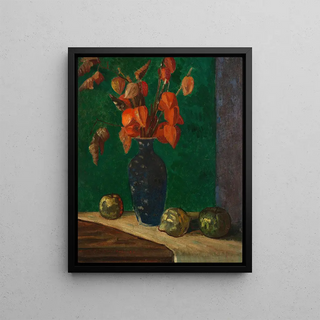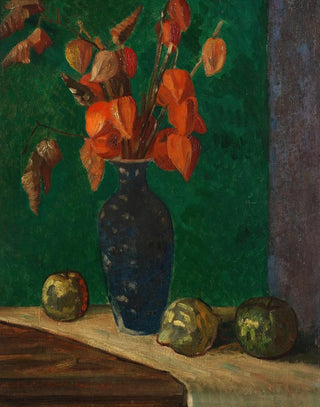Winter Cherries - Mark Gertler Art print


View from behind

Frame (optional)
In the rich and diverse universe of modern art, "Winter Cherries" by Mark Gertler stands out for its ability to capture the very essence of nature through a vibrant palette and bold composition. This artwork, created in 1916, evokes not only the beauty of cherries but also a sense of nostalgia and contemplation. By gazing at this piece, the viewer is transported to a world where the simplicity of the fruits becomes a symbol of a rich and complex inner life. Gertler succeeds in transforming a fleeting moment into a lasting visual experience, inviting everyone to explore the nuances of the winter season through its colors and shapes.
Style and uniqueness of the work
Gertler's style in "Winter Cherries" is a perfect example of his modernist approach, blending post-impressionist influences and elements of cubism. The composition of the artwork is characterized by clean lines and stylized forms, which give an impression of movement while maintaining a certain rigidity. The cherries, bursting with color, contrast with the more subdued background, creating a captivating visual dialogue. This chromatic choice is not accidental; it evokes both warmth and freshness, uniting contradictory emotions that echo the duality of life itself. Gertler manages to infuse an almost tactile dimension into his work, where each cherry seems ready to be picked, while inviting a deeper reflection on the ephemeral nature of beauty.
The artist and his influence
Mark Gertler, an emblematic figure of the British artistic movement of the early 20th century, is often associated with the Bloomsbury Group and other avant-garde artists of his time. His training at the Slade School of Fine Art shaped his unique style, pushing him to explore various themes ranging from nature to the human condition. Gertler's influence on his contemporaries is undeniable; he combined refined technique with emotional sensitivity, laying the groundwork for a new approach to painting. "Winter Cherries" is not only a work of art but also a testament to the evolution

Matte finish

View from behind

Frame (optional)
In the rich and diverse universe of modern art, "Winter Cherries" by Mark Gertler stands out for its ability to capture the very essence of nature through a vibrant palette and bold composition. This artwork, created in 1916, evokes not only the beauty of cherries but also a sense of nostalgia and contemplation. By gazing at this piece, the viewer is transported to a world where the simplicity of the fruits becomes a symbol of a rich and complex inner life. Gertler succeeds in transforming a fleeting moment into a lasting visual experience, inviting everyone to explore the nuances of the winter season through its colors and shapes.
Style and uniqueness of the work
Gertler's style in "Winter Cherries" is a perfect example of his modernist approach, blending post-impressionist influences and elements of cubism. The composition of the artwork is characterized by clean lines and stylized forms, which give an impression of movement while maintaining a certain rigidity. The cherries, bursting with color, contrast with the more subdued background, creating a captivating visual dialogue. This chromatic choice is not accidental; it evokes both warmth and freshness, uniting contradictory emotions that echo the duality of life itself. Gertler manages to infuse an almost tactile dimension into his work, where each cherry seems ready to be picked, while inviting a deeper reflection on the ephemeral nature of beauty.
The artist and his influence
Mark Gertler, an emblematic figure of the British artistic movement of the early 20th century, is often associated with the Bloomsbury Group and other avant-garde artists of his time. His training at the Slade School of Fine Art shaped his unique style, pushing him to explore various themes ranging from nature to the human condition. Gertler's influence on his contemporaries is undeniable; he combined refined technique with emotional sensitivity, laying the groundwork for a new approach to painting. "Winter Cherries" is not only a work of art but also a testament to the evolution






